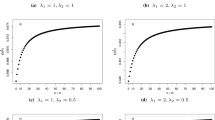Abstract
The two-parameter Weibull distribution is the most popular model for material strength. However, it may not be a good model for all materials over a wide range of sizes. In this note, a comprehensive review of the known variations of the two-parameter Weibull distribution is provided to help providing better modeling. Over 20 variations are reviewed. The appropriateness of the variations is discussed as models for brittle versus ductile strength. A comparison study of a selection of the variations is also provided. It is hoped that this review will also serve as an important reference and encourage developments of further variations of the two-parameter Weibull distribution.
Similar content being viewed by others
References
A. C. Cohen, The reflected Weibull distribution. Technometrics, 15 (1973) 867–873.
N. Balakrishnan and S. Kocherlakota, On the double Weibull distribution: order statistics and estimation. Sankhyā, 47 (1985) 161–176.
J. S. White, The moments of log-Weibull order statistics. Technometrics, 11 (1969) 373–386.
A. Drapella, Complementary Weibull distribution: unknown or just forgotton. Quality and Reliability Engineering International, 9 (1993) 383–385.
G. S. Mudholkar and G. D. Kollia, Generalized Weibull family: a structural analysis. Communications in Statistics—Theory and Methods, 23 (1994) 1149–1171.
R. P. McEwen and B. R. Parresol, Moment expressions and summary statistics for the complete and truncated Weibull distribution. Communications in Statistics—Theory and Methods, 20 (1991) 1361–1372.
A. W. Marshall and I. Olkin, A new method for adding a parameter to a family of distributions with application to the exponential and Weibull families. Biometrika, 84 (1997) 641–652.
V. G. Voda, New models in durability tool-testing: pseudo-Weibull distribution. Kybernetika, 25 (1989) 209–215.
E. W. Stacy, A generalization of gamma distribution. Annals of Mathematical Statistics, 33 (1962) 1187–1192.
M. E. Ghitany, On a recent generalization of a gamma distribution. Communications in Statistics—Theory and Methods, 27 (1998) 223–233.
G. S. Mudholkar, D. K. Srivastava and M. Freimer, The exponentiated Weibull family. Technometrics, 37 (1995) 436–445.
G. S. Mudholkar and A. D. Huston, The exponentiated Weibull family: some properties and a flood data application. Communications in Statistics—Theory and Methods, 25 (1996) 3059–3083.
M. M. Nassar and F. H. Eissa, On the exponentiated Weibull distribution. Communications in Statistics—Theory and Methods, 32 (2003) 1317–1336.
S. Nadarajah and A. K. Gupta, On the moments of the exponentiatedWeibull distribution. Communications in Statistics—Theory and Methods, 34 (2005) 253–256.
M. Xie, Y. Tang and T. N. Goh, A modified Weibull extension with bathtub-shaped failure rate function. Reliability Engineering & System Safety, 76 (2002) 279–285.
Z. Chen, A new two-parameter lifetime distribution with bathtub shape or increasing failure rate function. Statistics and Probability Letters, 49 (2000) 155–161.
Y. Tang, M. Xie and T. N. Goh, Statistical analysis of a Weibull extension model. Communications In Statistics—Theory and Methods, 32 (2003) 913–928.
J. W. Wu, H. L. Lu, C. H. Chen, and C. H. Wu, Statistical inference about the shape parameter of the new two-parameter bathtub-shaped lifetime distribution. Quality and Reliability Engineering International, 20 (2004) 607–616.
S. Nadarajah, On the moments of the modified—Weibull distribution. Reliability Engineering and System Safety, 90 (2005) 114–117.
C. D. Lai, M. Xie and D. N. P. Murthy, Modified Weibull model. IEEE Transactions on Reliability, 52 (2003) 33–37.
G. S. Mudholkar and D. K. Srivastava, Exponentiated Weibull family analyzing bathtub failure-rate data. IEEE Transactions on Reliability, 42 (1993) 299–302.
K. K. Phani, A new modifed Weibull distribution. Communications of the American Ceramic Society, 70 (1987) 182–184.
J. A. Kies, The strength of glass. Naval Research Lab Report No 5093, Washington DC, (1958).
J. E. Dennis and R. B. Schnabel, Numerical Methods for Unconstrained Optimization and Nonlinear Equations. Prentice-Hall, Englewood Cliffs, New Jersey, (1983).
R. B. Schnabel, J. E. Koontz and B. E. Weiss, A modular system of algorithms for unconstrained minimization. ACM Transactions on Mathematical Software, 11 (1985) 419–440.
R. Ihaka and R. Gentleman, R: A language for data analysis and graphics. Journal of Computational and Graphical Statistics, 5 (1996) 299–314.
G. Blom, Statistical Estimates and Transformed Beta-variables. John Wiley and Sons, New York, (1958).
J. Chambers, W. Cleveland, B. Kleiner and P. Tukey, Graphical Methods for Data Analysis. Chapman and Hall, (1983).
Author information
Authors and Affiliations
Corresponding author
Rights and permissions
About this article
Cite this article
Nadarajah, S., Kotz, S. Strength modeling using Weibull distributions. J Mech Sci Technol 22, 1247–1254 (2008). https://doi.org/10.1007/s12206-008-0426-5
Received:
Revised:
Accepted:
Published:
Issue Date:
DOI: https://doi.org/10.1007/s12206-008-0426-5



